As chefs from other regions moved to
Saigon, so their native local dishes arrived as well. Talented chefs from the
regions modified old dishes or created new ones that appealed to the taste of
diners, raising expectations that these will go further…
Even a simple leaf can
become a specialty
A salad made of terminalia catappa leaf;
broadbill swordfish grilled with terminalia catappa leaf prepared by Royal
Café’s chefs (Kim Do hotel); colocasia gigantea with crab cake; salad with
chicken and various leaves such as (noni tree, premna serratifolia and lotus)
made by Amor restaurant; stewed chicken with premna serratifolia leaf and
coconut juice; and beef mixed with young broccoli presented by chefs from the
Hotel Majestic.
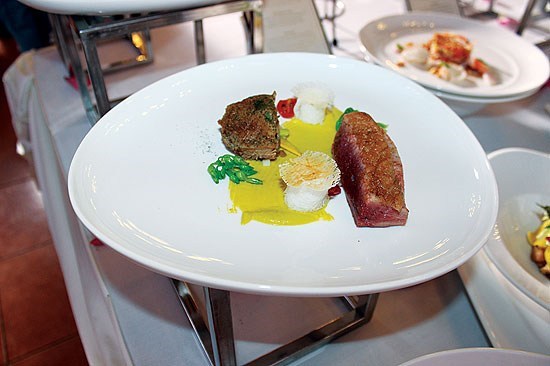
Roasted duck with coriander seeds and fried dill seeds
Chef Tho Van Le and his team from De Nhat
hotel bravely chose various leaves, typical of the countryside. These become
the highlights of their three course menu. There was an appetizer of chicken
salad made with banana tree and fish sauce and “lá giang” – a kind of leaf (scientific name Aganonerion
polymorphum). All of these are rustic and common ingredients but were combined
in a modern way ensuring all the dishes looked very beautiful, tasted delicious
and were very nutritious containing antibiotic properties.
“That
grilled duck with honey is inspired by the grilled chicken with Thai lemon
leaves from the That Son area (An Giang province). This is considered as a
special and unique spice with a taste of mint and a good aroma.” said the
chefs.
Furthermore the Thai lemon belongs to a
jungle lemon type of plant. Its leaves and fruit are normally used as spice. It
has been said that its name, stems from the fact that they are very popular in
the Ba Chuc area (Tri Ton, An Giang province), this is why it is called “lá chúc”.
Chefs from Van Thanh tourist area have
exploited to the maximum the flexibility of this tree to create a menu with
three delicious dishes: lobster steamed with Thai lemon leaves; chicken cooked
with Thai lemons; and sweet soup made of Thai lemon leaf jelly. Chefs of the Boulevard
(Kim Do hotel) have another innovation, making a hotpot of chicken and Thai
lemon leaf in coconut juice.
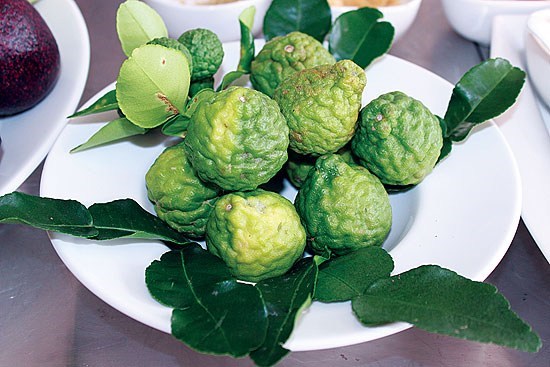
Thai lemon leaf and fruit
To deliver good aroma as well as the taste
of Thai lemon leaf isn’t easy. Chefs from the Van Thanh tourist area explained
that if we use too much Thai lemon leaves for dried food then it will cause a
strong and unpleasant smell and in soup dishes it can cause a bitter taste.
To avoid this problem, when using this
spice we should soak the leaves in warm water then immerse in cold water. With
the fruit it needs to be boiled for 15 minutes before cooking use. The chicken
soup with Thai lemon leaves is highly appreciated because of its great
combination between the sweetness and moisture of chicken meat and the oil essence
of spices from An Giang Mountain. The chicken used is called is “gà kiến” – which comes from the central
region whilst the vegetables hail from the South such as common sesban flowers
and water-lilies.
Rude jade before being sculptured
Nobody could know that“hoa lục bình” flower (scientific name
Eichhornia crassipes), found floating in rivers, could create such delicious
dishes like: salad made of “ngó lục bình”
(using only the youngest stem from the top of the flower; pickled “ngó lục bình”; salad of “hoa lục bình”; and sweet and sour “ngó lục bình”soup. When the chefs from
the Baby Spoon restaurant introduced the “ngó
lục bình” salad to diners, they were impressed by the dish, because of its
crispness and fresh and healthy taste.
Good dishes such as the rolls from Tay Son
area, rice noodle soup with chicken from Song Than area (An Thai town), rice
noodle soup with fish from Ca Mau and rice cake from Go Cong, were creatively
prepared by chefs through a concept of “Home taste”. Each one has an interesting story attached.
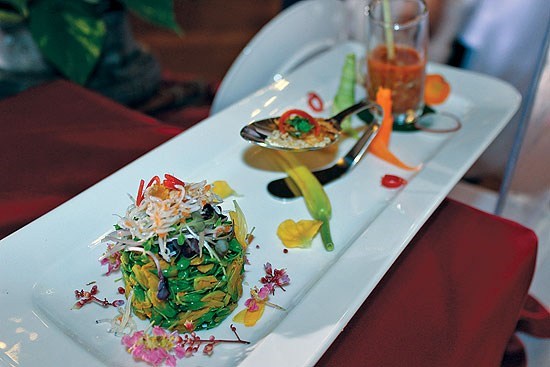
A salad of oyster sauce paste and common sesban flower
Many chefs travel to isolated town or
villages to look for shops or restaurants selling traditional dishes. Chef Dam
Duong Nguyen from the Hotel Majestic went to the Mekong Delta to learn recipes
of rice noodle soup, which is well known in Tra Vinh, Ca Mau, Soc Trang and Bac
Lieu.
Chef Jacklee Vien from Compass Parkview
restaurant is a Viet Kieu who has lived far away from his home town for more
than ten years. Besides studying Western cuisine, he still learns about
Vietnamese food; Extracted spices from vegetables and fruits so that each dish
will also have a medicinal value.
He and his team brought a special menu to
the Golden Spoon contest and won second prize with: fruit salad with prawns;
lobster soup with “lá đinh lăng” – a
kind of leaf (scientific name Polyscias fruticosa); beef filet with annona
sauce served with vegetables and red steamed rice; and crème brulee with
mangosteen and sticky rice made of “gấc”
fruit (scientific name Momordica cochinchinensis) and mixed fruits. “Vietnamese
foods have an incredible attraction that defies description. The rustic dishes
are very special because the spices and ingredients themselves are unique. All
fruit and vegetables are very cheap compared to America; a definite advantage.
This inspired me and made me want to learn more as well as introduce Vietnamese
foods to more people,” declared Chef Jacklee Vien.
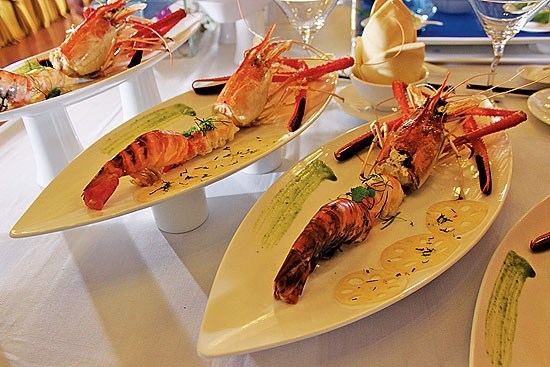
Lobster steamed with Thai Lemon leaves
Food expert Suong Thi Bui paid great
attention to discovering high quality rustic dishes of young chefs. As she puts
it many Vietnamese dishes are like crude jade before being sculptured, promoted
to improve and commercialized to reach a larger audience.
Like the story of Thai lemon leaves: when
she was in Belgium with a Vietnamese delegation to attend a food festival she
realized that the Thai lemon leaves were widely available in big stores in
Western countries, whereas Vietnamese have so many special spices that don’t
leave the small and unknown villages in remote areas of the country-side.
47 teams in the
semi-final
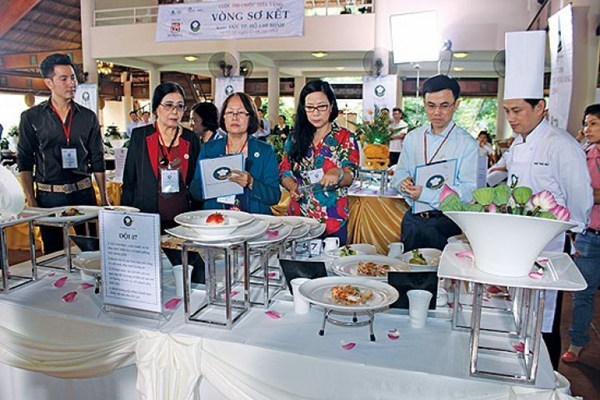
The judges evaluating the presentation session of Caravelle Hotel team
The 2014 Golden Spoon with the theme of
“Home taste in the integration times” took place on May 21st and has
seen 10 rounds attract the participation of 160 restaurants from 40 provinces
with 330 dishes. These varied from rustic to creative dishes from the wealth of
Vietnamese food treasures and were added to the Vietnam cuisine map.
The organizer selected 47 teams to go
through to the semi-final. As planned the semi-final of the 2014 Golden Spoon
Contest will take place in Hanoi on November 5th and the semi-final
in South region will be on November 19th.
The Golden Spoon Contest has a total prizes
value of more than VND three billion. The first prize is VND 1 billion and
other prizes for the rounds in each region.
The contest is co-organized by Minh Long I Limited Company and the
Center of Business Research and Enterprise Support. It is funded by Ly’s Horeca
under sponsorship of two national units: the Chamber of Commerce - Industry of
Vietnam (VCCI) and Vietnam National Administration of Tourism. The final will
be in Binh Duong province on December 10th 2014.
Followed by Nguyen Trang
The Gioi Tiep Thi magazine